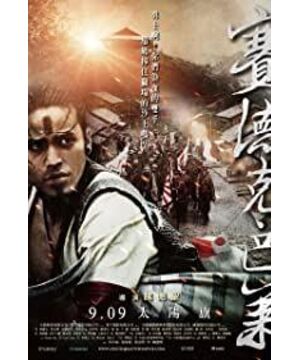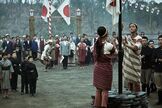It can be said that "The Flag of the Sun", as a Taiwanese film, has set a benchmark for Taiwan's future films, and is an important turning point in recovering the spiritual culture of Taiwanese film.
"The Flag of the Sun" is not from Hollywood, not from a big-budget production in mainland China, but from a place like Taiwan. There is no excessive plot rendering and no cumbersome lines. Everything is a seamless connection of long flowing waters, silence when it should be silent, revolt when it should be uprising, epiphany when it should be epiphany, and magnificent when it should be magnificent.
As an anti-Japanese film, "The Flag of the Sun" is often compared with "The Thirteen Hairpins of Jinling" by Zhang Yimou, a leading mainland director. Relatively speaking, "The Thirteen Hairpins of Jinling" uses a group of pure female college students to render the gripping selfless and unyielding spirit of resisting Japan. "The Flag of the Sun" is placed in the history of the anti-Japanese war of the nation of Seediq, which is largely realistic. It tells the process of anti-Japanese from the life course of a local nation.
When a barbaric civilization faces an aggressor's cultural civilization, should it succumb to change or resist and save itself. Whether the spirit and heritage of a nation should be oppressed and obstructed. This is reflected in the negotiation and awakening through the two roles of police officers for Japanese rule and Mona Ludo.
The film is divided into two processes, one is Mona Ludao's youth, the other is his old age.
The bravery and unrestrainedness of the youth ended in the cry of being crushed in the head pit by the Japanese soldiers, but in the later years, there was a seemingly forbidding fortitude and the wisdom to deal with the clan and the Japanese.
As an immortal leader, Mona Ludo's life deserves to be remembered. However, through the changes in Mona Ludao's life, it also expresses from one side the unimaginable length of time that the Sediq nation was invaded and oppressed by Japan.
In our eyes, a 150-minute film is indeed a life of oppression at that time.
In the process of watching the movie, I have been looking forward to the final resistance and uprising. The righteous side will definitely win, but this victory must pay a price. This price is not only the sacrifice of the nation's compatriots, but also the tortuous and lost faith in the lives of the next generation of the nation. When a group of students killed their Japanese teachers and their families together when they resisted, the mentality of the ethnic youth has actually been reflected in the Japanese cultural aggression and injustice over the years. The kind of humiliation imposed on them that did not belong to their youthful spirit.
Seediq is a nation worthy of being remembered. There is no need for too much emotional color, oppression and resistance, return to spiritual ancestors or shrines, fading and erosion of culture.
Education, as the most basic method of preaching and teaching, has become crucial at this moment and changes the history and future of a nation.
Perhaps in the eyes of our generation, the history of being invaded has almost been forgotten, and there is no trace or history of being destroyed by culture, but history still clearly tells us that as long as it exists, it will not disappear. .
View more about Sai de ke · ba lai: Tai yang qi reviews











